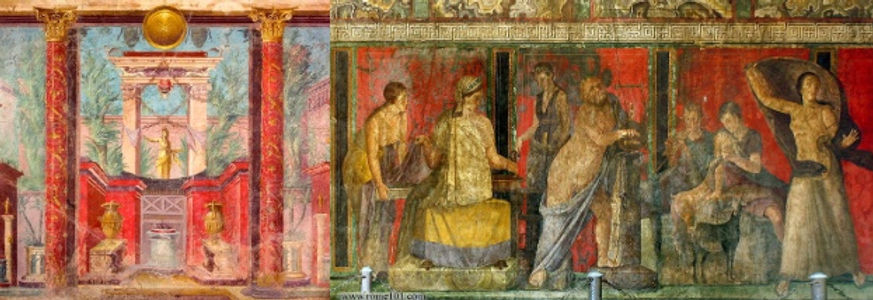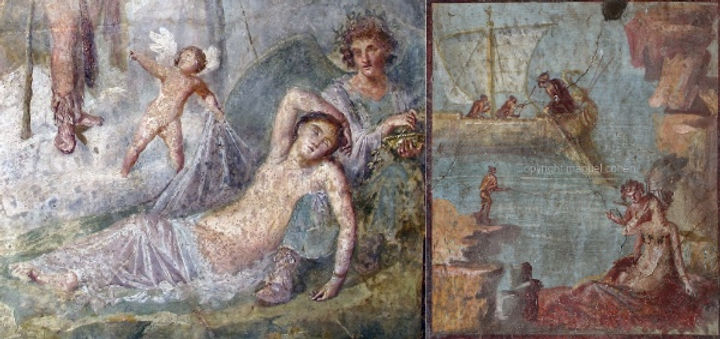POMPEIAN STYLES
The Four Pompeian Styles
The Pompeian Styles represent four different periods of Roman wall painting found in Pompeii, Herculaneum, and other towns that Mount Vesuvius buried in 79 CE. These styles show how artistic techniques, visual preferences, and cultural attitudes evolved over nearly three centuries of Roman home decoration.
August Mau developed this classification system in the late 1800s, and art historians still use his four-style framework today:
First Style: 200-80 BCE
Second Style: 80-15 BCE
Third Style: 15 BCE-50 CE
Fourth Style: 50-79 CE (the year of the eruption)
First Style (200-80 BCE)
The First Style sought to imitate expensive building materials through painted stucco relief work. Walls were divided into horizontal bands and rectangular panels that mimicked costly marble and stone veneers. Artists used raised plaster moldings to create the illusion of ashlar masonry blocks, with painted surfaces replicating precious marbles in vibrant colors like deep purples, rich yellows, and brilliant reds.
This technique involved applying thick layers of stucco that were carved and painted to simulate three-dimensional architectural elements. The style allowed homeowners to achieve the appearance of luxury without the cost of actual marble veneer while displaying symbols of aristocratic taste.

Second Style (80-15 BCE)
The Second Style marked a shift toward sophisticated trompe-l'oeil techniques designed to "fool the eye." This approach used painting to create optical illusions of objects existing in three-dimensional space, transforming how Romans experienced interior spaces.
Artists painted elaborate architectural elements like columns, pediments, and entablatures that appeared to extend rooms beyond their physical boundaries. These painted features made small atriums seem larger and more grandiose, creating illusions of spacious colonnades and garden vistas. The technique required careful attention to perspective, light, and shadow to achieve convincing effects.
The Villa of Mysteries outside Pompeii exemplifies this style, where painted columns appear to support a real ceiling while opening onto imaginary landscapes. The Second Style also incorporated large-scale figure paintings that seemed to inhabit the painted architectural spaces, depicting mythological narratives or religious ceremonies visible through painted windows.

Third Style (15 BCE-50 CE)
The Third Style departed from architectural illusionism toward decorative fantasy. Where the Second Style convinced viewers of spatial reality, the Third Style emphasized artificial ornament and elegant refinement. Walls became flat decorative surfaces adorned with delicate, fantastical elements.
This style featured impossibly thin architectural elements that could never support actual weight. Reed-like columns, wispy candelabra, and gossamer architectural frames served purely decorative purposes. Color palettes became more sophisticated, with subtle harmonies of black, red, and yellow backgrounds supporting intricate ornamental details.
Central panels often contained small mythological scenes or still-life paintings, treated as precious artworks within the decorative scheme. These were rendered with exquisite detail and framed by elaborate ornamental borders. The overall effect emphasized precious refinement rather than spatial grandeur.

Fourth Style (50-79 CE)
The Fourth Style combined elements from all previous styles while adding new levels of complexity and theatrical drama. This approach reflected the cultural diversity and artistic experimentation of the period.
Fourth Style walls featured architectural elements reminiscent of earlier styles but executed with greater fantasy. Artists created impossible architectural visions like floating pavilions, fantastical stage sets, and dreamlike cityscapes that defied physical laws. These compositions often incorporated multiple perspective systems, creating visually exciting but spatially impossible environments.
Colors became more varied and sometimes discordant, reflecting experimentation with new pigments. Central panels featured complex mythological narratives that demonstrated the high level of artistic skill available to Pompeian patrons.

Artistic Techniques and Materials
Throughout all four styles, Pompeian artists employed sophisticated techniques demonstrating their mastery of Greek artistic traditions and Roman innovations. Decorative arts included intricate mosaics created from tesserae, small hand-cut cubes of stone, glass, or ceramic arranged to create complex images.
The Alexander Mosaic, also known as the Battle of Issus Mosaic, exemplifies extraordinary Roman skill. Originally from the House of the Faun in Pompeii, this masterpiece contains over one million tesserae arranged to create a dynamic battle scene between Alexander the Great and Darius III of Persia. The mosaic demonstrates sophisticated understanding of perspective, movement, and psychological drama.
Fresco techniques involved applying pigments to wet lime plaster, allowing colors to bond chemically with the wall surface for exceptional durability. Artists worked quickly while the plaster remained workable, requiring extensive planning and skill. The volcanic ash that buried Pompeii maintained color intensity that continues to astonish modern viewers.
The four Pompeian styles provide an unparalleled window into Roman artistic development over nearly three centuries. They demonstrate how Roman artists adapted Greek traditions while developing distinctly Roman approaches to domestic decoration, offering invaluable insights into Roman civilization at its height.
